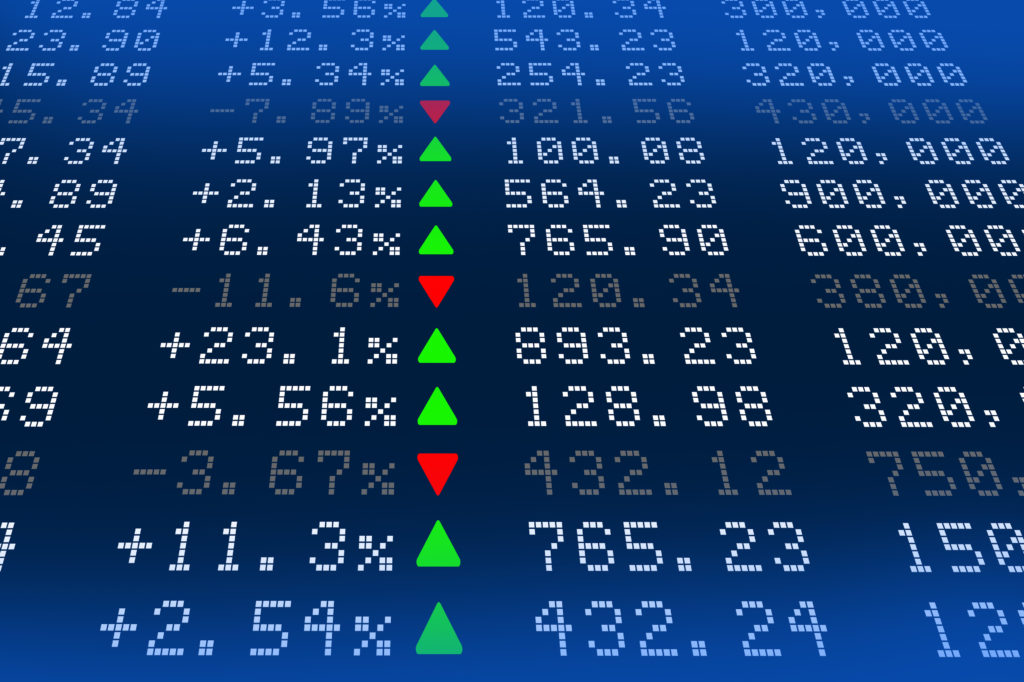Welcome to Freestone Capital Management’s sixth quarterly Economic Outlook.
- Over the past few months, the United States made considerable progress in combatting the COVID-19 global pandemic. Total administered doses of a coronavirus vaccine are at a pace of close to three million per day. Vaccination deployment could put an end to social distancing measures and lead to the reopening of service sector businesses. These two factors should pave the way for a meaningful pick-up in economic growth and improvements in the labor market.
- This report will focus on three main macroeconomic indicators. Firstly, a discussion about the heightened level of debt in the country, which grew as a biproduct of the stimulus packages passed by two administrations since March 2020. Secondly, a review of economic activity in the U.S. and the importance of the American consumer to Gross Domestic Product. Lastly, the pandemic had an unrivaled impact on employment factors, and while there is still room to improve, there is optimism among those in the service sector.
- During the last version of the Economic Outlook, one of the economic metrics to follow was the U.S. housing market. The end of this report furthers the conversation with updated data and a few viable explanations as to why home prices continue to edge higher.
- Thank you for being a reader of this quarter’s Economic Outlook. The past year or so has been challenging, but it appears better days are upon us.
Overview
For the last 15 months most discussions or reports involving the domestic economy tend to start with a review and update of the COVID-19 global pandemic. Fortunately, there appears to be light at the end of the tunnel in the form of herd immunity.
Upon examination of the seven-day moving average of confirmed infections and fatalities of the virus in the U.S., it appears the worst is in the rearview mirror. After the second wave spiked in the winter months, the country is making remarkable progress against the pandemic. The recent downward trend in both cases and deaths leads to the question – when will life return to some degree of normalcy?
The following chart and table provide some information to help answer this question. Per the Center for Disease Control and Prevention, roughly one in three individuals are fully vaccinated. Under the assumption that this pace of immunizations continues, the number of infections and deaths should continue to rapidly decline over the next few months. Vaccine deployment has the full support of the federal government, with President Joe Biden setting a new goal of administering at least one COVID-19 vaccine dose to 70% of the American adult population by the Fourth of July. Given that nearly 57% of people aged 18 years or older have already received a first dose, this target appears reasonable. For these reasons, it feels as though life will largely return to normal by the fall of 2021.
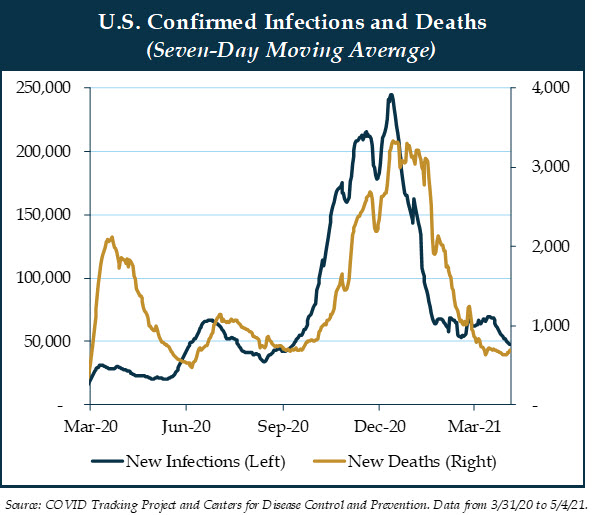
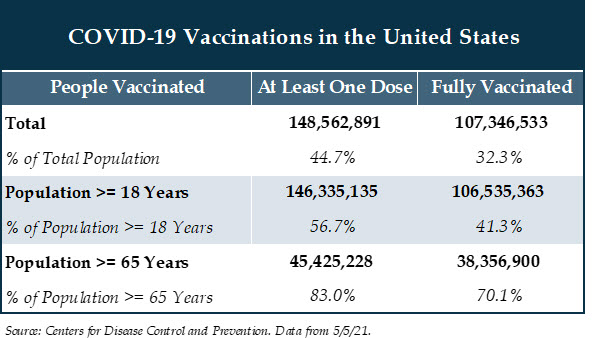
But how did we get to this point of withstanding a once-in-a-century global pandemic? Market commentators would point to the amount of government spending pushed into the economy. These unprecedented levels of support via stimulus should push the federal government to a new record high debt to Gross Domestic Product (“GDP”) ratio by the end of fiscal 2021.
Despite heightened levels of debt, the economy responded well to the combination of vaccine deployment and additional stimulus. During the first quarter of the year, U.S. GDP grew at a 6.4% annualized pace. Powered by the domestic consumer, the economy posted its second fastest pace for growth since 2003 and was only outdone by the reopening-fueled surge of the third quarter of last year.
With vaccine deployment and a decline in confirmed infections, states accelerated their reopening initiatives during the first few months of the year. The easing of COVID-19 restrictions led to a partial recovery in the labor market as service industry businesses reopened their doors. Lessening pandemic pressure will likely continue to have a positive impact on the labor market.
For those reading this report that recently bought a house or listed their home for sale, it goes without saying that the domestic housing market is booming. Home prices rose 11.3% year-over-year in March as record low mortgage rates, unsatiable demand, and limited available inventory pushed home prices higher.
Federal Government Debt
Forecasts of the federal budget over the next year suggest that the U.S. will reach a new record high debt to GDP ratio by the end of fiscal year 2021. This new level would be even higher than the amount of debt taken on in the aftermath of World War II. In order to combat the pandemic, two administrations accumulated a pandemic relief tab of $5 trillion. This unparalleled spending over the last 15 months led to an outsized debt burden. It is important to note that current projections do not include the potential cost of Biden’s infrastructure plan, thus underestimating the true level of debt. As shown in the following chart, public debt as a percentage of GDP skyrocketed over the past year with no signs of slowing down in the near-term.
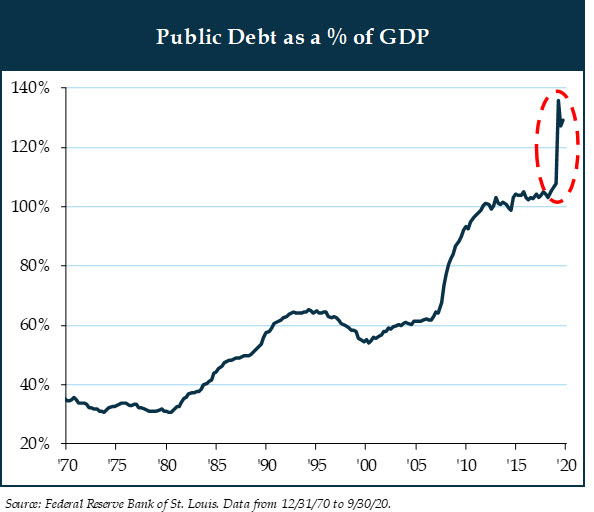
Most economists do not believe elevated debt levels will result in a fiscal crisis over the next few years, but it is an item to follow as pandemic pressures ease. Failure to restrain deficits in conjunction with an accelerating economy in the wake of vaccines might lead to problems. For example, an increase in inflationary pressures could result in higher interest rates and taxes, setting the stage for an economic pullback. Some of these factors are outlined in the Congressional Budget Office’s (“CBO”) Baseline Economic Assumptions as displayed in the following table.

Economic Growth Prospects
During the first quarter of the year, the domestic economy grew at a 6.4% annualized rate. The recent $1.9 trillion stimulus package aided in that performance. To give a sense for how large this last round of stimulus was, let’s take a look at policies that were enacted to fight the Great Depression of the 1930s. Economists believe roughly $789 billion (in today’s dollars) was pressed into the domestic economy, which is approximately 41.5% of Biden’s plan. Granted, today’s economy is much larger, but the scale and impact of the pandemic on day-to-day life cannot be understated. The size of the recent package is just one of many examples that proves it. This package is estimated to deliver $1.2 trillion of additional spending in the economy over six months. Most of this money is also being sent to lower- or middle-income households, which typically have a higher propensity to spend.
The first quarter’s boost was primarily driven by the U.S. consumer, as spending accelerated 10.7% quarter-over-quarter compared to the 2.3% advance in the prior period. While most of the spending was focused on goods, which rose 23.6%, spending on services gained momentum and grew by 4.6%. Eligible Americans spent some of their $1,400 stimulus checks and also tucked a decent slice of it into savings. The personal savings rate flew to 21%, up from 13% during the last quarter of 2020. The elevated savings rate suggests that Americans are flush with cash. As restrictions are reduced and vaccine deployment continues, most economists expect a boost in spending in the worst impacted services (e.g., leisure, hospitality, travel, arts, etc.) while spending on goods remains stable.
It is widely believed the economy is primed for a surge in 2021. Feeding this upward momentum is a retreating COVID-19 virus and additional stimulus. Just over two thirds of GDP is derived from consumption, highlighting its importance to the U.S. economy. Given lockdown measures over the past year, there exists pent-up demand and supply in the sectors most impacted by the pandemic (i.e., service and leisure related sectors). The expectation is that these businesses will reopen quickly, leading to high single digit economic growth during the second half of the year and into 2022. Current projections believe that growth in the next few quarters will push the economy close to a full recovery, before returning to its long-term growth pace of roughly 2% that was experienced until the end of 2019.

Job Gains
While the initial recovery in the labor market is positive, the overall pace seems to have slowed down as businesses adapt to working with less employees. Most of the remaining decline is in pandemic sensitive sectors that still aren’t fully reopened. For example, hotels, restaurants, bars, airlines, and cruise lines will likely have the hardest time returning to some semblance of normalcy and will therefore take their time in bringing back employees.
The U.S. unemployment rate currently stands at 6.1%, but economic experts argue it does not encompass the true degree of economic hardship since close to 4 million people dropped out of the labor force since March 2020. These individuals are not counted in the calculation of the unemployment rate, suggesting that the true unemployment rate might be higher. On the positive side, as the service sector rebounds in the second half of 2021 and early 2022, expectations are for improved job growth, with forecasters estimating that the unemployment rate could fall in the 4.5% to 5.0% range by year-end.
Housing Market
The domestic housing market’s strength so far this year is unwavering. According to CoreLogic, an analytics and data services company, home prices rose 11.3% year-over-year in March across the country. They attributed the potency to: (i) historically low mortgage rates, (ii) COVID-19 prompted migration patterns, including millennials aging into homeownership, (iii) and record low available supply. As of the end of February, housing inventory plummeted 30% over the prior 12 months to a record low of just over one million homes. During the quarter, homes typically sold in just 20 days, representing another record low.
The housing market can be explained through a relatively simple math equation; record low supply + spiking demand = strong home price appreciation.
Another factor making homes more expensive is an increase in input costs. A survey conducted by the National Association of Home Builders (“NAHB”) reported that 69% of builders named building materials as their top challenge when constructing new homes. The main culprit is the shortage of lumber. As shown below, prices for lumber are on the rise in recent months, making it much more expensive to build a home. The NAHB estimates the elevated price of lumber alone is adding roughly $24,000 to the price of a new home.
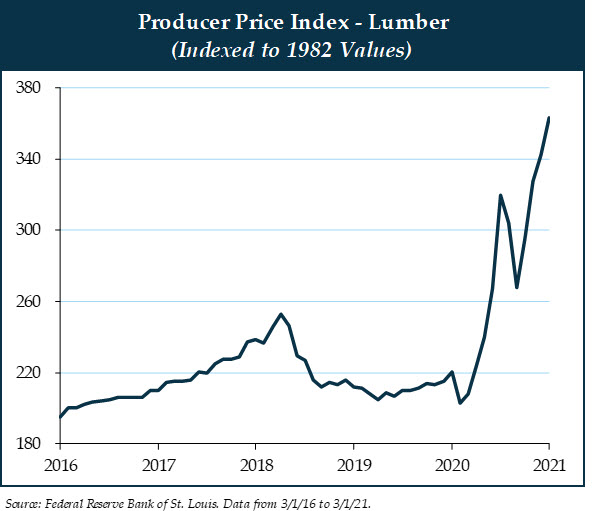
Concluding Remarks
The last 15 months included a flurry of events even when excluding the COVID-19 global pandemic and subsequent vaccine roll-out. The Australian and west coast wildfires, a stock market crash and ensuing rally, and a federal election along with many other events led to a strenuous time for most.
During this period, a quote from the 32nd President of the United States, Franklin D. Roosevelt comes to mind – a smooth sea never made a skilled sailor.
As we head into the second half of 2021, economists and market followers tend to agree that better days are coming. The underlying macroeconomic data presented throughout this report tends to follow that sentiment. Ultimately, it appears life as we knew it pre-pandemic has been altered. The question is – by how much?
As always, we thank you for entrusting us with your capital.
Important Disclosures: Past performance is not a reliable indicator of future results. Please see important disclosures at the end of this document.This document contains general information, opinions and market commentary and is only a summary of certain issues and events that we believe might be of interest generally. Nothing in this document is intended to provide, and you should not rely on it for, accounting, legal, tax or investment advice or recommendations. We are not making any specific recommendations regarding any security or investment or wealth management strategy, and you should not make any decisions based on the information in this newsletter. While we believe the information in this document is reliable, we do not make any representation or warranty concerning the accuracy of any data in this document and we disclaim any liability arising out of your use of, or reliance on, such information. The information and opinions in this document are subject to change without notice, and we do not undertake any responsibility to update any information herein or advise you of any change in such information in the future. This document speaks only as of the date indicated. Past performance of any investment or wealth management strategy or program is not a reliable indicator of future results. Portions of this document constitute “forward-looking statements” and are subject to a number of significant risks and uncertainties. Any such forward-looking statements should not be relied upon as predictions of future events or results.
